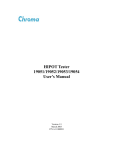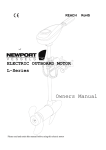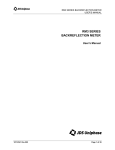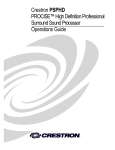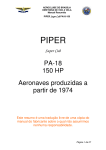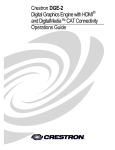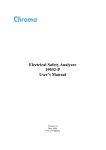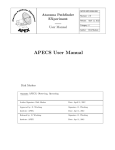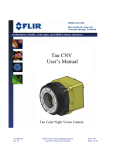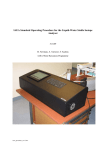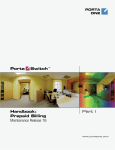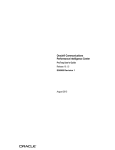Download JDS SB Series Manual - Artisan Technology Group
Transcript
Artisan Technology Group is your source for quality new and certified-used/pre-owned equipment • FAST SHIPPING AND DELIVERY • TENS OF THOUSANDS OF IN-STOCK ITEMS • EQUIPMENT DEMOS • HUNDREDS OF MANUFACTURERS SUPPORTED • LEASING/MONTHLY RENTALS • ITAR CERTIFIED SECURE ASSET SOLUTIONS SERVICE CENTER REPAIRS Experienced engineers and technicians on staff at our full-service, in-house repair center WE BUY USED EQUIPMENT Sell your excess, underutilized, and idle used equipment We also offer credit for buy-backs and trade-ins www.artisantg.com/WeBuyEquipment InstraView REMOTE INSPECTION LOOKING FOR MORE INFORMATION? Visit us on the web at www.artisantg.com for more information on price quotations, drivers, technical specifications, manuals, and documentation SM Remotely inspect equipment before purchasing with our interactive website at www.instraview.com Contact us: (888) 88-SOURCE | [email protected] | www.artisantg.com SB SERIES FIBEROPTIC SWITCH User’s Manual Artisan Technology Group - Quality Instrumentation ... Guaranteed | (888) 88-SOURCE | www.artisantg.com Artisan Technology Group - Quality Instrumentation ... Guaranteed | (888) 88-SOURCE | www.artisantg.com Contents Safety Information, Instructions, and Symbols.......................................................................1 Safety Information ...........................................................................................................1 Classification .......................................................................................................1 Disconnecting from Line Power ...........................................................................1 Line Power Requirements ...................................................................................1 Fuse Type............................................................................................................1 Safety Instructions...........................................................................................................2 Before Initializing and Operating the Unit ............................................................2 Operating the Unit ...............................................................................................2 Safety Symbols ...............................................................................................................4 Compliance .....................................................................................................................5 CE Compliance....................................................................................................5 General Information and Specifications ..................................................................................6 General Information ........................................................................................................6 Single-Common (SB-C) Switch Configuration .....................................................6 Dual-Common (SB-D) Switch Configuration ........................................................7 Single Step Dual Common (SB-E) Switch Configuration .....................................7 Dual-Common Blocking (SB-F) Switch Configuration ..........................................8 Key Features .......................................................................................................8 Applications .........................................................................................................8 Standard Accessories..........................................................................................8 Optional Accessories ...........................................................................................8 Specifications ..................................................................................................................9 Getting Started ........................................................................................................................11 Before Initializing and Operating the Unit......................................................................11 Initial Inspection.............................................................................................................11 Operating Environment .................................................................................................11 Temperature ......................................................................................................12 Humidity.............................................................................................................12 Ventilation..........................................................................................................12 Storing and Shipping.....................................................................................................12 Claims and Repackaging...................................................................................12 Returning Shipments to JDS Uniphase .............................................................12 Cleaning Connectors.....................................................................................................13 Installing the Switch.......................................................................................................14 Operating and Maintenance Instructions ..............................................................................15 Front Panel....................................................................................................................15 Operating Keys..................................................................................................15 Status LEDs.......................................................................................................15 Rear Panel ....................................................................................................................16 External Switch Module Connections ............................................................................16 External Switch Module without TTL Input Controls...........................................16 External Switch Module with TTL Input Controls................................................17 SD000153 Rev. J May 2000 Artisan Technology Group - Quality Instrumentation ... Guaranteed | (888) 88-SOURCE | www.artisantg.com Sample Driver Application: Electrical Equivalent of Driver.............................................17 Powering Up the Switch ................................................................................................18 Using and Selecting a Channel .....................................................................................18 Setting the GPIB Address .............................................................................................19 Setting the Interface Command Set for SC and SX Switches .......................................19 Controlling the Drivers...................................................................................................19 Controlling the Switch Locally .......................................................................................20 Controlling the Switch Remotely by GPIB Interface ......................................................20 Controlling the Switch Remotely by RS232 Interface....................................................20 Calibrating the Switch....................................................................................................21 Maintaining the Switch ..................................................................................................21 Programming Guide................................................................................................................23 GPIB Pin Assignment....................................................................................................23 Setting the GPIB Address .............................................................................................23 GPIB Interface Functions ..............................................................................................24 RS232 Pin Assignment .................................................................................................24 RS232 Interface Specifications .....................................................................................24 RS232 Driver Pin Assignment .......................................................................................25 Operation and Query Commands .................................................................................25 Command Parser Rules.....................................................................................25 Operation Commands........................................................................................26 Query Commands..............................................................................................27 Status Reporting and Service Request Control.............................................................29 Condition Register .............................................................................................29 Status Register ..................................................................................................29 SRQ Mask Register ...........................................................................................30 GPIB Programming Examples.......................................................................................30 Sending Commands ..........................................................................................31 Serial Polling the Status Register ......................................................................31 Generating a Service Request Interrupt ............................................................32 Learn Query (LRN?) ..........................................................................................32 RS232 Programming Examples ....................................................................................32 Sending Commands ..........................................................................................33 Querying Status.................................................................................................33 Reading the Status Register ..............................................................................33 Setting the Interface Command Set ..............................................................................33 SC Series Switch Command Set (SCXXX-0XXX Models) .................................34 SX Series Switch Command Set .......................................................................34 SD000153 Rev. J May 2000 Artisan Technology Group - Quality Instrumentation ... Guaranteed | (888) 88-SOURCE | www.artisantg.com For sales and service information, contact JDS Uniphase or your local representative. JDS Uniphase Corporation 570 West Hunt Club Road Nepean, Ontario, Canada K2G 5W8 Phone: 613 727-1303 Fax: 613 727-8284 E-mail: [email protected] Website: http://www.jdsunph.com SD000153 Rev. J May 2000 Artisan Technology Group - Quality Instrumentation ... Guaranteed | (888) 88-SOURCE | www.artisantg.com Safety Information, Instructions, and Symbols Safety Information Classification The unit consists of an exposed metal chassis that is connected directly to earth via a power cord and, therefore, is classified as a Class 1 instrument. Class 1 refers to equipment relying on ground protection as a means of shock protection. The following symbol is used to indicate a protective conductor terminal in the unit. Disconnecting from Line Power Some of the circuits are powered whenever the unit is connected to the AC power source (line power). To ensure that the unit is not connected to the line power, disconnect the power cord from either the power inlet on the unit’s rear panel or from the AC line-power source (receptacle). The power cord must always be accessible from one of these points. If the unit is installed in a cabinet, the operator must be able to disconnect the unit from the line power by the system’s line-power switch. Line Power Requirements The unit can operate from any single-phase AC power source that supplies between 100 and 240 V at a frequency range of 50 to 60 Hz. The maximum power consumption is 80 VA. Fuse Type The fuse type used by the unit is (5x20) mm, T1A / 250 V (slow). Safety – 1 Artisan Technology Group - Quality Instrumentation ... Guaranteed | (888) 88-SOURCE | www.artisantg.com Safety Instructions The following safety instructions must be observed whenever the unit is operated, serviced, or repaired. Failure to comply with any of these instructions or with any precaution or warning contained in the user’s manual is in direct violation of the standards of design, manufacture, and intended use of the unit. JDS Uniphase assumes no liability for the customer’s failure to comply with any of these safety requirements. Before Initializing and Operating the Unit Inspect the unit for any signs of damage, and read the user’s manual thoroughly. Install the unit as specified in the Getting Started section. Ensure that the unit and any devices or cords connected to it are properly grounded. Operating the Unit Warning To avoid the risk of injury or death, always observe the following precautions before initializing the unit: • If using a voltage-reducing autotransformer to power the unit, ensure that the common terminal connects to the earthed pole of the power source. • Use only the type of power cord supplied with the unit. • Connect the power cord only to a power outlet equipped with a protective earth contact. Never connect to an extension cord that is not equipped with this feature. • Willfully interrupting the protective earth connection is prohibited. • Never look into the end of an optical cable connected to an optical output device that is operating. Laser radiation is invisible, and direct exposure can severely injure the human eye. For more information, see the user’s manual of the laser source in use. • Turning off the power to the device does not always block the externally supplied radiation to the connector at the output of the unit. • Do not use the unit outdoors. • To prevent potential fire or shock hazard, do not expose the unit to any source of excessive moisture. • Do not operate the unit when its covers or panels have been removed. • Do not interrupt the protective earth grounding. Any such action can lead to a potential shock hazard that can result in serious personal injury. • Do not operate the unit if an interruption to the protective grounding is suspected. In this case, ensure that the unit remains inoperative. • Use only the type of fuse specified by the manufacturer as appropriate for this unit. Do not use repaired fuses, and avoid any situations that can short- Safety – 2 Artisan Technology Group - Quality Instrumentation ... Guaranteed | (888) 88-SOURCE | www.artisantg.com circuit the fuse. • Unless absolutely necessary, do not attempt to adjust or perform any maintenance or repair procedure when the unit is opened and connected to a power source. • Repairs are to be carried out only by a qualified professional. • Do not attempt any adjustment, maintenance, or repair procedure to the unit’s internal mechanism if immediate first aid is not accessible. • Disconnect the power cord from the unit before adding or removing any components. • Operating the unit in the presence of flammable gases or fumes is extremely hazardous. • Do not perform any operating or maintenance procedure that is not described in the user’s manual. • Some of the unit’s capacitors can be charged even when the unit is not connected to the power source. Safety – 3 Artisan Technology Group - Quality Instrumentation ... Guaranteed | (888) 88-SOURCE | www.artisantg.com Safety Symbols The following symbols and messages can be marked on the unit (Table 1). Observe all safety instructions that are associated with a symbol. Table 1: Safety Symbols Symbol Description Laser safety. See the user’s manual for instructions on handling and operating the unit safely. See the user’s manual for instructions on handling and operating the unit safely. Electrostatic discharge (ESD). See the user’s manual for instructions on handling and operating the unit safely. Frame or chassis terminal for electrical grounding within the unit. Protective conductor terminal for electrical grounding to the earth. WARNING The procedure can result in serious injury or loss of life if not carried out in proper compliance with all safety instructions. Ensure that all conditions necessary for safe handling and operation are met before proceeding. CAUTION The procedure can result in serious damage to or destruction of the unit if not carried out in compliance with all instructions for proper use. Ensure that all conditions necessary for safe handling and operation are met before proceeding. Safety – 4 Artisan Technology Group - Quality Instrumentation ... Guaranteed | (888) 88-SOURCE | www.artisantg.com Compliance CE Compliance The unit has been designed and tested to comply with directive 73/23/EEC and its subsequent amendments by the European Community (EC or CE). The directive relates to electrical equipment designed for use within certain voltage limits. It ensures that electrical equipment is constructed with good engineering practice in safety matters. The unit has been designed and tested to comply with directive 89/336/EEC, exclusive of the 1997 amendment. The directive relates to electromagnetic compatibility. It demands that electromagnetic disturbance does not exceed a prescribed level; that the equipment be immune to a prescribed level of ambient level of interference; that the equipment be protected against electrostatic discharges; and that the equipment be immune to all electrical shock wave disturbances. The requirements specified by directive 89/336/EEC are as follows. CE compliance requires that the manufacturer or its authorized representative established within the Community affix the EC conformity mark to the apparatus or else to the packaging, instructions for use, or guarantee certificate. The EC conformity mark shall consist of the letters CE as specified and the figures of the year in which the mark was affixed. This mark should, where appropriate, be accompanied by the distinctive letters used by the notified body issuing the EC typeexamination certificate. Where the apparatus is the subject of other Directives providing for the EC conformity mark, the affixing of the EC mark shall also indicate conformity with the relevant requirements of those other Directives. Safety – 5 Artisan Technology Group - Quality Instrumentation ... Guaranteed | (888) 88-SOURCE | www.artisantg.com General Information and Specifications General Information This user’s manual for the SB Series Fiberoptic Switch contains complete operating instructions. The SB Series 1xN programmable switches are designed to connect a single fiberoptic input channel to any of N (up to 48) output channels (Figure 1). The performance, configuration, flexibility, and portable enclosure are suitable for a wide range of applications, including fiberoptic component testing systems, remote fiber test systems in telecommunications, and research and development. Single-mode and multimode versions of the switches are available. The SB Series switches are bidirectional. Figure 1: SB Switch The SB switch connects the input to a selected output channel. The terminations are precisely aligned by a processor-controlled stepper motor. Collimating lenses terminate the fiberoptic attachments, minimizing the insertion loss of the switch and improving the repeatability and stability of its parameters. The SB switch is equipped with IEEE 488.1 parallel and RS232 serial interfaces for remote operation. The switch also is operated manually using the front-panel controls. The switch status is displayed on the front-panel indicators. The SB switch is available in single-common (SB-C) and dual-common (SB-D, SB-E, and SBF) configurations. The dual-common units support two (paired) fiberoptic input channels. Single-Common (SB-C) Switch Configuration The common input channel (C) is connected to the output channel (1). The reset position (0) of the switch is an open circuit. This configuration is shown in Figure 2. General Information and Specifications – 6 Artisan Technology Group - Quality Instrumentation ... Guaranteed | (888) 88-SOURCE | www.artisantg.com Figure 2: Single-Common Configuration Dual-Common (SB-D) Switch Configuration The D configuration provides simultaneous connection of a bank of inputs to outputs (Figure 3). The input A can be connected to 1A of 1B or …(N/2)A. In this dual-common configuration, channel connections are stepped in pairs. The channel displayed is the current channel pair (A and B). The number of channel pairs is equal to one-half of the total number of channels (N). Figure 3: Dual-Common Configuration Single Step Dual Common (SB-E) Switch Configuration This non-blocking configuration allows any input to be connected to any output, but at the same time, adjacent inputs align with adjacent outputs (Figure 4). This configuration allows for single-step movement of paired input channels (A and B). The channel connection displayed is B path; A input channel is connected to B path minus one. General Information and Specifications – 7 Artisan Technology Group - Quality Instrumentation ... Guaranteed | (888) 88-SOURCE | www.artisantg.com Figure 4: Single-Step Dual-Common Configuration Dual-Common Blocking (SB-F) Switch Configuration This configuration allows one of the inputs to be aligned with an output in a blocking sense, with reduced output channel counts available (Figure 5). Figure 5: Dual-Common Blocking Configuration Key Features • • • • • Up to 48 channels Typical insertion loss 0.4 dB Typical repeatability 0.003 dB Typical return loss 65 dB Local control and remote control via IEEE 488 and RS232 interfaces Applications • • • • Remote fiber test systems in telecommunication networks Fiberoptic component testing Transmitter/receiver measurement Research and development Standard Accessories • • AC power cord User’s manual Optional Accessories • Rack-mount kit General Information and Specifications – 8 Artisan Technology Group - Quality Instrumentation ... Guaranteed | (888) 88-SOURCE | www.artisantg.com Specifications The following optical specifications describe the warranted characteristics of the unit ( Table 2). Supplementary specifications describe the typical non-warranted performance of the unit (Table 3 and Table 4). Table 2: Optical Specifications Parameter 0.4 dB 0.3 dB 0.7 dB 0.6 dB Return loss single-mode2 standard/analog multimode3 standard/analog 65 dB/>65 dB 25 dB/35 dB 60 dB/65 dB (minimum) 20 dB/30 dB (minimum) Polarization dependent loss (single-mode) 0.02 dB 0.05 dB Insertion loss stability4 ±0.03 dB ±0.05 dB Repeatability5 sequential switching random switching ±0.003 dB ±0.01 dB ±0.005 dB ±0.025 dB Crosstalk (single-mode) -100 dB -80 dB Input power (continuous wave) 300 mW — Switching time one channel each additional channel 2 3 4 5 Maximum Insertion loss single-mode1 multimode1 Channel options front-panel FC or ST connectors front-panel SC connectors 5 m rear-panel pigtail 1 Typical 20 (maximum) 24 (maximum) 48 (maximum) 300 ms (typical) +12 ms (typical) Insertion loss does not include connectors. Include 0.2 dB (typical), 0.5 dB (maximum) for each connector. Excluding connectors. Values shown for 62.5 µm diameter maximum fiber core. Drift of any channel relative to one assigned reference channel at ±3 °C deviation of ambient temperature over a seven-day period. Optimum repeatability after one hour warm-up. General Information and Specifications – 9 Artisan Technology Group - Quality Instrumentation ... Guaranteed | (888) 88-SOURCE | www.artisantg.com Table 3: Operating Specifications Local control • • • • • Remote control • GPIB interface: IEEE 488.1 1987 capability SH1, AH1, T6, L4, SR1, PP0, DC1, C0, E1 Step-up, step-down channel selection Control of one external relay driver IEEE 488.1 address selection Return-to-local function Language selection • RS232 interface: setting 8 bits, 1200 baud, 1 stop bit, no parity Command set Revised command set. Capable of emulating command set of JDS Uniphase SC-0 and SX-0 Series switch models. Drivers Eight open collector outputs, sink current 100 mA maximum per output (driver): • Drivers 1, 2, 3, 4, +5V, and GND (ground) are accessible from back panel connector • Drivers 5, 6, 7, and 8 are internal • Driver 1 can also be controlled from the DRIVER1 key on the front panel Warm-up time1 1 1 hour at 25 °C ambient temperature Applicable for optimum repeatability performance. Table 4: Other Specifications Electrical Input voltage 100 to 240 V AC, 50 to 60 Hz Power consumption 80 VA maximum Physical Dimensions (W x H x D) standard with rack-mount kit1 21.2 x 8.9 x 35.5 cm 48.3 x 8.9 x 35.5 cm Weight 3.75 kg Environmental 1 Operating temperature 0 to 55 °C Storage temperature -40 to 70 °C Humidity maximum 95% RH from 0 to 55 °C Rack-mount kit is optional. General Information and Specifications – 10 Artisan Technology Group - Quality Instrumentation ... Guaranteed | (888) 88-SOURCE | www.artisantg.com Getting Started The SB Series Fiberoptic Switch consists of the switch unit and an AC power cord. The rackmount kit is optional. Before Initializing and Operating the Unit Inspect the unit for any signs of damage. Read the user’s manual thoroughly, and become familiar with all safety symbols and instructions to ensure that the unit is operated and maintained safely. Initial Inspection Warning To avoid electrical shock, do not initialize or operate the unit if it bears any sign of damage to any portion of its exterior surface, such as the outer cover or panels. Check that the unit and contents are complete: 1. Wear an anti-static wrist strap, and work in an electrostatic discharge (ESD) controlled area. 2. Inspect the shipping container for any indication of excessive shock to the contents, and inspect the contents to ensure that the shipment is complete. 3. Inspect the unit for structural damage that can have occurred during shipping. 4. Connect the unit to a power source, using the AC power cord provided. 5. Set the power switch to I (on) to initialize the SB switch. All key lamps and status LEDs light. If no malfunction is detected during power-up, all lamps and LEDs turn off and the display reads 0. If a malfunction is detected during the power-up sequence, an error message is displayed. 6. Set the power switch to O (off), and disconnect the AC power cord from the power supply and from the unit. 7. Keep the packaging. Immediately inform JDS Uniphase and, if necessary, the carrier if the contents of the shipment are incomplete, if the unit or any of its components are damaged or defective, or if the unit does not pass the initial inspection. Operating Environment In order for the unit to meet the warranted specifications, the operating environment must meet the following conditions for temperature, humidity, and ventilation. Getting Started – 11 Artisan Technology Group - Quality Instrumentation ... Guaranteed | (888) 88-SOURCE | www.artisantg.com Temperature The unit can be operated in the temperature range of 0 to 55 °C. Humidity The unit can be operated in environments with up to 95% humidity (0 to 55 °C). Do not expose it to any environmental conditions or changes to environmental conditions that can cause condensation to form inside the unit. Ventilation The unit contains a built-in cooling fan. Do not install it in any location where the ventilation is blocked. For optimum performance, the unit must be operated from a location that provides at least 75 mm (3 inches) of clearance at the rear and at least 25 mm (1 inch) of clearance at the bottom. Blocking the air circulation around the unit can cause the unit to overheat, compromising its reliability. Warning • Do not use the unit outdoors. • To prevent potential fire or shock hazard, do not expose the unit to any source of excessive moisture. Storing and Shipping To maintain optimum operating reliability, do not store the unit in locations where the temperature falls below -40 °C or rises above 70 °C. Avoid any environmental condition that can result in internal condensation. Ensure that these temperature and humidity requirements can also be met whenever the unit is shipped. Claims and Repackaging Immediately inform JDS Uniphase and, if necessary, the carrier, if • • • The contents of the shipment are incomplete The unit or any of its components are damaged or defective The unit does not pass the initial inspection In the event of carrier responsibility, JDS Uniphase will allow for the repair or replacement of the unit while a claim against the carrier is being processed. Returning Shipments to JDS Uniphase JDS Uniphase only accepts returns for which an approved Return Material Authorization (RMA) has been issued by JDS Uniphase sales personnel. This number must be obtained prior to shipping any material to JDS Uniphase. The owner’s name and address, the model number and full serial number of the unit, the RMA number, and an itemized statement of claimed defects must be included with the return material. Getting Started – 12 Artisan Technology Group - Quality Instrumentation ... Guaranteed | (888) 88-SOURCE | www.artisantg.com Ship return material in the original shipping container and packing material. If these are not available, packaging guidelines are as follows: 1. Wear an anti-static wrist strap and work in an ESD controlled area. 2. Cover the front panel with a strip of cardboard. 3. Wrap the unit in anti-static packaging. Use anti-static connector covers, if applicable. 4. Pack the unit in a reliable shipping container. 5. Use enough shock-absorbing material (10 to 15 cm or 4 to 6 in on all sides) to cushion the unit and prevent it from moving inside the container. Pink poly anti-static foam is the best material. 6. Seal the shipping container securely. 7. Clearly mark FRAGILE on its surface. 8. Always provide the model and serial number of the unit and, if necessary, the RMA number on any accompanying documentation. 9. Ship the unit only to the address given at the beginning of this document. Cleaning Connectors Caution • Connecting damaged or dirty fibers to the unit can damage the connectors on the unit. • Never force an optical connector. Some connectors have a ceramic ferrule that can easily be broken. Optical cable ends need to be cleaned before using them with the unit. The following items are required for cleaning: • • • • Filtered compressed air or dusting gas (for example, Tech Spray Envi-Ro-Tech Duster 1671 gas, available from http://www.techspray.com/1671.htm) Lint-free pipe cleaners (for example, from 3M1) or lint-free swab Lint-free towels (for example, 10 x 10 cm or 4 x 4 in HydroSorb III wipers, available from http://www.focenter.com/acctech/hydrosobr_wipers.htm) Optical grade isopropyl alcohol or optical grade 200° ethanol (do not use rubbing alcohol, which contains 30% water) To clean the connectors: 1 3M is a trademark of 3M. Getting Started – 13 Artisan Technology Group - Quality Instrumentation ... Guaranteed | (888) 88-SOURCE | www.artisantg.com 1. Blow the sleeve with filtered compressed air (Figure 6). Figure 6: Connector Cleaning (connector type can vary) 2. Apply optical grade isopropyl alcohol or optical grade ethanol (do not use rubbing alcohol) to a small area of a lint-free towel and rub the end of the ferrule over the wet area. 3. Wipe the ferrule on a dry area of the lint-free towel. 4. Using the dusting gas or compressed air, blow the end of the ferrule. 5. Apply the alcohol or ethanol to a lint-free pipe cleaner or swab and wipe off the remaining parts of the connector. 6. With the other end of the pipe cleaner or swab, dry the areas cleaned. 7. Using the dusting gas or compressed air, blow the areas cleaned. Installing the Switch Warning In sensitive applications, to avoid shock and vibration, do not mount the switch in non-rigid racks or on top of raised floors or tables. Avoid use with highimpact doors that lack impact-reducing bumpers upon closing. To install the switch: 1. Place the SB switch into its intended operating location. 2. Avoid blocking the ventilation holes at the back and at the bottom of the instrument. 3. Do not pull on the fibers exiting through the rear-panel strain relief. Excessive force can damage the optics. 4. Route the fiber cables in such a way as to avoid creating bends that have a radius of less than 1.5 cm; do not lay cables across sharp corners or tie bundles of cables together tightly. 5. Reattach the AC power cord and reinitialize the switch. Getting Started – 14 Artisan Technology Group - Quality Instrumentation ... Guaranteed | (888) 88-SOURCE | www.artisantg.com Operating and Maintenance Instructions Front Panel The front of the switch is shown in Figure 7. Figure 7: Front of the Switch Operating Keys The operating keys are described in Table 5. Table 5: Operating Keys Key Description I/O Turns the power on (I) and off (O) DRIVER 1 Toggles driver 1 on and off GPIB ADDR Sets the switch to GPIB Address (IEEE 488.1) mode LOCAL Returns the switch to Local mode from Remote mode ▲ Channel increment key ▼ Channel decrement key Status LEDs The status LEDs are described in Table 6. Operating and Maintenance Instructions – 15 Artisan Technology Group - Quality Instrumentation ... Guaranteed | (888) 88-SOURCE | www.artisantg.com Table 6: Status LEDs LED Description REM Indicates that the GPIB or RS232 interface is in Remote mode. All front-panel keys except Local are locked out. LOCK Indicates that the SB switch is in Local Lockout mode. This mode prevents the Local key from returning the SB switch to Local mode. ADDR Indicates that the GPIB interface is in talk or listen state SRQ Indicates that the interrupt logic of the SB switch has generated a service request interrupt on the GPIB interface Rear Panel The back of the switch is shown in Figure 8. Figure 8: Back of the Switch External Switch Module Connections External Switch Module without TTL Input Controls The setup for a switch without transistor-to-transistor logic (TTL) is shown in Figure 9. Operating and Maintenance Instructions – 16 Artisan Technology Group - Quality Instrumentation ... Guaranteed | (888) 88-SOURCE | www.artisantg.com Figure 9: Switch Setup without TTL External Switch Module with TTL Input Controls The setup for a switch with TTL is shown in Figure 10. Figure 10: Switch Setup with TTL Sample Driver Application: Electrical Equivalent of Driver A sample driver application is shown in Figure 11. Operating and Maintenance Instructions – 17 Artisan Technology Group - Quality Instrumentation ... Guaranteed | (888) 88-SOURCE | www.artisantg.com Figure 11: Sample Driver Application: Electrical Equivalent of Driver Caution Do not exceed 100 mA per driver. Powering Up the Switch To power up the switch: 1. Connect the switch to the AC power source with the AC power cord provided. 2. Set the power switch to I (on) to initialize the SB switch. All key lamps and status LEDs light. If no malfunction is detected during power-up, all lamps and LEDs turn off, and the display reads 0. Using and Selecting a Channel To use the switch: 1. Connect a channel to the front of the switch (Figure 12). Figure 12: Using a Channel Operating and Maintenance Instructions – 18 Artisan Technology Group - Quality Instrumentation ... Guaranteed | (888) 88-SOURCE | www.artisantg.com To select a channel: 1. Press the ▲ or ▼ key to scroll to the channel number required. The switch mechanism advances to the channel when the key is released. In SB-C models (SB1CXXXXX+2XXXXXXXX), the channel number displayed is the current channel number connected to the common fiber C (the switch has one common fiber). In the SB-D models (SB2DXXXXX+2XXXXXXXX), the channel number displayed is the current channel pair (the switch has two common fibers). In the SB-E models (SB2EXXXXX+2XXXXXXXX), the channel number displayed is the channel connected to the common fiber B. The channel connected to the common fiber A is B - 1 (the switch has two common fibers). In SB-F models (SB2FXXXXX+2XXXXXXXX), the channel number displayed is the channel connected to the common fiber B. A blocked connection with B shows as an even-numbered channel and the connected channels with B show as odd-numbered. The path connected to common fiber A is B - 1. In all configurations, channel 0 is an open circuit, that is, the switch is in an unconnected state. Setting the GPIB Address Set the SB switch to GPIB mode to display and edit the GPIB address: 1. Press the GPIB ADDR key. The current GPIB address is displayed. 2. To change the address, press the ▲ or ▼ key to scroll to the required address. 3. Press the GPIB ADDR key to store the new address. Or, to exit GPIB mode without changing the address, press the DRIVER 1 key. Setting the Interface Command Set for SC and SX Switches The SB switch can be set to emulate the interface command sets of earlier models of JDS Uniphase SC Series and SX Series switches. To set the interface command set: 1. Press and hold the GPIB ADDR key while the SB switch powers up. The active interface command set is displayed. 2. Press the ▲ key to scroll to the required command set, for example, SB, SC, or SX. 3. Press the GPIB ADDR key to save the setting. Controlling the Drivers The SB switch has four drivers (drivers 1, 2, 3, and 4) for driving the external switch modules and four drivers (drivers 5, 6, 7, and 8) for driving internal switch modules in custom Operating and Maintenance Instructions – 19 Artisan Technology Group - Quality Instrumentation ... Guaranteed | (888) 88-SOURCE | www.artisantg.com applications. All drivers are controlled by remote commands (use the Driver port at the back of the switch). Driver 1 can also be controlled locally by the Driver 1 key. To control driver 1 locally: 1. Press the Driver 1 key to toggle driver 1 on and off for manual control. The status LED of the key is lit when on. Controlling the Switch Locally To operate the switch using the front panel: 1. If the REM status LED is lit, press the Local key once to set the SB switch to Local mode. 2. Press the ▲ or ▼ key to select the switch position required. In SB-E configurations, the display shows the common B switch position. Common A is set to the display reading minus one. 3. To toggle external relay driver 1, press the Driver 1 key. This driver can be used to operate a 1x2 source select switch. The status LED key is lit when on. Controlling the Switch Remotely by GPIB Interface To control the switch by GPIB interface: 1. Connect a user-supplied GPIB cable to the controlling computer and to the IEEE 488 (GPIB) port at the back of the switch. 2. Verify that the interface command set is set to SB and that the GPIB address is set to 7. To do this, turn the SB switch off and then on again. The display reads SB when set to SB mode. See the Setting the Interface Command Set section for instructions on changing the interface command set. 3. At the computer that controls the GPIB, set the message terminating character sequence to carriage return and line feed (<CR><LF>), for example, ASCII character code 13, 10. The <CR><LF> characters must be appended to the end of any messages sent to the SB switch. Similarly, the switch appends these characters to all messages it returns. 4. Send a sample command to the SB switch; for example, use an OUTPUT statement (or equivalent) to send the command CLOSE 10 at GPIB address 7. The channel setting changes to 10. Most programming languages automatically append the terminating sequence to the message. 5. Send a sample query command, for example, CLOSE?; then use an INPUT statement to receive the message 10 from GPIB address 7. Controlling the Switch Remotely by RS232 Interface To control the switch by RS232 interface: 1. Connect an RS232 cable to the RS232C port of the SB switch and to a computer. Operating and Maintenance Instructions – 20 Artisan Technology Group - Quality Instrumentation ... Guaranteed | (888) 88-SOURCE | www.artisantg.com 2. At the computer, initialize the serial port to 1200 baud, eight bit ASCII character code, one 2 stop bit, and no parity. Use the following MS-DOS Qbasic program as an example: OPEN "COM2;1200,N,8,1" FOR RANDOM AS #1 PRINT #1, "CLOSE 5" PRINT #1, "CLOSE? " INPUT #1,A$ PRINT A$ END Calibrating the Switch No calibration is required. Maintaining the Switch Clean the connector ends with a lint-free tissue and alcohol before every mating. See the Cleaning Connectors section. Clean the internal connectors and the panel-mounted connector bulkheads periodically or when high losses are suspected. The internal connectors can be accessed by removing the connector panel: 1. Remove the retaining screws of the connector panel. 2. Slowly pull the panel out to the full extent of its guide rails (Figure 13). Figure 13: Removing the Connector Panel 3. Remove the connectors from the connector bulkheads. 4. Clean the connector ends and the bulkhead mating sleeves with a lint-free tissue and alcohol. 5. Reinstall the connectors into the bulkheads. 2 MS-DOS is a registered trademark of Microsoft Corporation. Operating and Maintenance Instructions – 21 Artisan Technology Group - Quality Instrumentation ... Guaranteed | (888) 88-SOURCE | www.artisantg.com 6. Reinstall the connector panel, guiding the fibers back to ensure that they do not bend sharply. Operating and Maintenance Instructions – 22 Artisan Technology Group - Quality Instrumentation ... Guaranteed | (888) 88-SOURCE | www.artisantg.com Programming Guide The following programming instructions for the SB switch are intended for users who are familiar with the GPIB interface and how to send or receive messages over a device. A detailed description of the GPIB interface is contained in ANSI/IEEE Std. 488.1-1987 IEEE Standard Digital Interface for Programmable Instrumentation, published by the Institute of Electrical and Electronics Engineers. The SB switch is equipped with a GPIB parallel interface and an RS232C serial interface. The switch accepts the same device dependent commands (commands that control the instrument) over either interface. The SB switch can be set to emulate the interface command sets, status reporting, and service request control of the SC Series and SX Series switches. The active interface command set is displayed when the switch is powered on. See the Setting the Interface Command Set section for instructions on changing the interface command set. GPIB Pin Assignment The GPIB pin assignment is shown in Figure 14. Figure 14: GPIB Pin Assignment Caution Tighten the connector lock screws by hand. Do not use a screwdriver. Setting the GPIB Address To display or edit the GPIB interface address: 1. Press the GPIB ADDR key to set the switch to GPIB mode. The current GPIB address is displayed. (The factory-set GPIB address is 7.) 2. To change the address, press the ▲ or ▼ key to scroll to the required address. Programming Guide – 23 Artisan Technology Group - Quality Instrumentation ... Guaranteed | (888) 88-SOURCE | www.artisantg.com 3. Press the GPIB ADDR key. The new address is activated and stored. To leave the GPIB address unchanged, press the Driver 1 key. GPIB Interface Functions The GPIB interface functions are listed in Table 7. Table 7: GPIB Interface Functions Mnemonic Function SH1 source handshake, complete capability AH1 acceptor handshake, complete capability T6 basic talker, serial poll, not addressed if MLA L4 basic listener, not addressed if MTA SR1 service request capability RL1 remote/local, complete capability PP0 parallel poll, no capability DC1 device clear, complete capability DT0 device trigger, no capability C0 controller, no capability E1 electrical interface, open collector drivers RS232 Pin Assignment The RS232 pin assignment is shown in Figure 15. Figure 15: RS232 Pin Assignment RS232 Interface Specifications Table 8 lists the RS232 interface specifications. Programming Guide – 24 Artisan Technology Group - Quality Instrumentation ... Guaranteed | (888) 88-SOURCE | www.artisantg.com Table 8: RS232 Interface Specifications Name Symbol Pin Number Signal Direction transmitted data TxD 2 out received data RxD 3 in request to send RTS 8 out clear to send CTS 7 in data terminal ready DTR 6 out signal ground SG 5 — The data protocol is permanently set to 1200 baud ASCII character code, with eight bits per character, one stop bit, and no parity bit. The serial port of the controlling computer must be configured with the same settings. RS232 Driver Pin Assignment The RS232 driver pin assignment is shown in Figure 16. Figure 16: Driver Pin Assignment Caution Do not exceed 100 mA per driver. Operation and Query Commands Operation and query commands control instrument functions and are interface-independent. Command Parser Rules • A command consists of a mnemonic (for example, CLOSE) and, if required, a data parameter. The mnemonic and the data parameter must be separated by at least one space. • Parameters can be entered in various formats; for example, 10, 10.0, and 1.0e1 are all recognized as the same value. • Commands can be sent in uppercase or lowercase characters. Programming Guide – 25 Artisan Technology Group - Quality Instrumentation ... Guaranteed | (888) 88-SOURCE | www.artisantg.com • A command is contained in a message, and messages can contain more than one command, each one separated by a semicolon (;). For example, CLOSE 6;XDR 2 1 <CR> <LF> contains two commands. • All GPIB commands must end with the terminating sequence <CR> <LF>. • All RS232 commands must be terminated with a single <CR> character. • The input buffer of the switch can hold as many as 100 characters. If the buffer becomes full, the switch holds the handshaking line on the GPIB interface until space is available. Similarly, over the RS232 interface, the switch sets the Clear To Send line low. Any characters received after the line goes low are ignored. • Commands are executed as they are parsed; consequently, a command can be executed before the entire message in which it is contained is received. • The switch delays accepting new characters sent over the GPIB interface while the switch mechanism is moving, but no data are lost. The SB switch is always ready to accept characters over the RS232 interface. • A query command is used to extract status information from the switch. For example, SRE? <CR> <LF> returns the contents of the status register. • Multiple-command messages can contain only one query command. A query must be the last command in the message, for example, CLOSE 20; XDRS? <CR> <LF>. Operation Commands RESET Reset Returns the switch to the power-up state, for example, channel 0, relay drivers off. CLOSE i Set Optical Channel Closes the optical path represented by the integer i. XDR i k Driver Control Sets the specified external driver on or off. • • • i = driver number (1 to 8) k = 1 (on) k = 0 (off) Programming Guide – 26 Artisan Technology Group - Quality Instrumentation ... Guaranteed | (888) 88-SOURCE | www.artisantg.com XDRS i Drivers Control Sets all eight relay drivers according to the binary conversion of i. The binary weight of the drivers is as follows: • • • • • • • • Driver 1 = 1 Driver 2 = 2 Driver 3 = 4 Driver 4 = 8 Driver 5 = 16 Driver 6 = 32 Driver 7 = 64 Driver 8 = 128 Add together the weights of the drivers to be activated, and send the total. For example, when i = 255, all eight relay drivers are turned on. SRE i SQR Mask Writes a decimal number to the SRQ mask register (see the Status Reporting and Service Request Control section). Setting a bit to 1 generates an SRQ interrupt when the corresponding bit in the status register changes from 0 to 1. CSB Clear Status Byte Resets the status byte. CLR Clear Device Clears the SRQ mask register and the status register. Query Commands CLOSE? Optical Switch Path Returns the current optical path number. If the switch has two common input fibers (A and B), CLOSE? returns the position of fiber B. CLOSE? MAX returns the maximum channel number. XDR? i Driver Returns the state of an external relay driver (i). • • 0 = relay driver is off 1 = relay driver is on Programming Guide – 27 Artisan Technology Group - Quality Instrumentation ... Guaranteed | (888) 88-SOURCE | www.artisantg.com XDRS? Drivers Returns the states of all drivers in a binary-coded integer. LRN? Learn Returns a string containing three commands that, if sent, reset the switch to its current state, for example, CLOSE i;XDRS k;SRE l, where i represents the current path number, k represents the states of the external drivers, and l represents the value of the service request enable register. STB? Status Register Returns a three-digit integer and automatically clears the status register if the SRQ bit is set. SRE? SRQ Mask Returns the contents of the SRQ mask register. CNB? Condition Register Returns the contents of the condition register. TST? Self-Test Executes a self-test operation. An error code that can be queried with ERR? or LERR? is placed in an error queue. The query TST? also sets bit 7 in the status register. • • 0 = self-test passed 1 = self-test failed ERR? Error Number Returns an error number if the self-test fails. • • 330 = self-test failed 0 = self-test did not fail LERR? Last Number Error Returns a three-digit error number from the error queue. The queue can contain as many as five error numbers. The first error read is the last error that occurred. LERR? returns 000 if the error queue is empty. Programming Guide – 28 Artisan Technology Group - Quality Instrumentation ... Guaranteed | (888) 88-SOURCE | www.artisantg.com OPC? Operation Complete Returns the status of the input buffer. • • 1 = the input buffer is empty, for example, all commands have been executed 0 = the input buffer is not empty, for example, commands are still pending IDN? Identifier Returns a string that identifies the manufacturer, the switch series, and the firmware level, for example, JDS Uniphase, SB Switch, 2.00 Status Reporting and Service Request Control The SB switch maintains three eight-bit registers that are used for status reporting and for enabling the GPIB service request interrupt: • • • Condition register Status register SRQ mask register Condition Register The condition register monitors the current state of the switch mechanism ( Table 9). Bit 2, the settled condition bit, is 1 when the switch mechanism has stopped at the desired channel and 0 when the switch is moving to a new output channel. The CNB? query command returns the value of the condition register. When the settled bit is true, CNB? query returns 4. Table 9: Condition Register Condition Register Bit 7 Bit 6 Bit 5 Bit 4 Bit 3 Bit 2 Bit 1 Bit 0 0 0 0 0 0 settled 0 0 Status Register The status register records errors and other events that have occurred in the switch (Table 10). When an event occurs, the switch status logic sets the corresponding bit to 1. The status register can be read at any time because the bits stay set until the register is read at least once. Table 10: Status Register Status Register Bit 7 Bit 6 Bit 5 Bit 4 Bit 3 Bit 2 Bit 1 Bit 0 self-test service syntax message 0 settled 0 parameter Programming Guide – 29 Artisan Technology Group - Quality Instrumentation ... Guaranteed | (888) 88-SOURCE | www.artisantg.com error request error available error • Bit 7 (self-test error) is set if a calibration error is detected after power-up or after the self-test query (TST?) is executed. At all other times it is 0. • Bit 6 (service request) is set when the interrupt request logic of the switch detects a reason to generate a service request interrupt on the GPIB interface. • Bit 5 (syntax error) is set when the parser detects a syntax error in a command mnemonic. • Bit 4 (message available) is set when a message is available in the output buffer. • Bit 2 (settled) is set when bit 2 in the condition register changes from 0 to 1. • Bit 0 (parameter error) is set when a parameter value is out of the range of the SB switch. The status register can be read with the status register query (STB?) or by serial polling the GPIB interface. During power-up, the status register contains 0 and can only be read by serial polling. After initial power-up, only the settled bit (bit 2) is set to 1. The clear status byte command (CSB) and the clear device command (CLR) clear the status register. STB? also clears the status register, but only if the service request bit (bit 6) is set to 1. SRQ Mask Register The SRQ mask register unmasks specific events in the status register that generate service request interrupt on the GPIB interface (Table 11). The SRQ mask command (SRE) writes to the SRQ mask register. When a bit in the SRQ mask register is set to 1, the interrupt logic of the switch monitors the corresponding event bit in the status register. When a bit changes from 0 to 1, a service request interrupt is generated and bit 6 in the status register is set. Table 11: SRQ Mask Register SRQ Mask Register Bit 7 Bit 6 Bit 5 Bit 4 Bit 3 Bit 2 Bit 1 Bit 0 self-test error n/a syntax error message available n/a settled n/a parameter error The SRQ mask register can unmask more than one event at a time. The first unmasked event to change from 0 to 1 causes an interrupt. To acknowledge this interrupt, the GPIB interface can be serial polled or the status register can be read with STB?. The first time the SB switch is serial polled after an SRQ is generated, bit 6 is on. Subsequent serial polling returns a value with bit 6 off. Similarly, STB? returns the status register with the SRQ bit set, but then the switch logic automatically clears the register. As a result, subsequent STB? queries return 0. The SRQ mask register is cleared by powering up the SB switch, by the clear device command (CLR), or by the universal device clear command ( DC1). GPIB Programming Examples This section provides programming samples for controlling the SB switch over the GPIB interface. The samples were written in MS-DOS Qbasic and run on a personal computer Programming Guide – 30 Artisan Technology Group - Quality Instrumentation ... Guaranteed | (888) 88-SOURCE | www.artisantg.com equipped with a National Instruments3 GPIB interface board, with National Instruments Universal Language Interface drivers loaded. The commands that control the GPIB are similar 4 to Hewlett Packard HP Basic commands. Most other controller board manufacturers provide basic output and input statements for communicating messages to a GPIB instrument. Before using any of these samples, ensure that the GPIB address is set to 7, the interface command set is SB, the ULI.EXE driver is loaded, and the switch is connected to the computer via a GPIB cable. The GPIB commands provided in this section do not always show the terminating sequence <CR><LF>; however, it is implied. Sending Commands This example sets the SB switch to channel 6 and turns on all the external relay drivers. ' set up the interface card and drivers OPEN "GPIB0" FOR OUTPUT AS #1 OPEN "GPIB0" FOR INPUT AS #2 PRINT #1, "ABORT" ' set terminating character to CR LF sequence PRINT #1, "GPIBEOS OUT CR LF" PRINT #1, "GPIBEOS IN CR LF" ' sample commands"close 6; xdrs 255" PRINT #1, "OUTPUT 07;CLOSE 6;XDRS 255" ' sample queries PRINT #1, "OUTPUT 07;CLOSE?" PRINT #1, "ENTER 07" INPUT #2, a PRINT "channel ",a PRINT #1, "OUTPUT 07;XDRS?" PRINT #1, "ENTER 07" INPUT #2, a PRINT "driver state ",a END Serial Polling the Status Register This example changes the channel setting and reads the status register continuously until the output has settled. PRINT #1, "OUTPUT 07;csb" bit PRINT #1, "OUTPUT 07;CLOSE 12" sr = 0 WHILE ((sr AND 4 ) =0) PRINT #1, "SPOLL 07" INPUT #2, sr 3 4 National Instruments Hewlett Packard is a ' clearing the status byte clears the settling ' change channel ' initialize sr variable to enter the while loop ' loop until settled bit is true ' serial poll SB switch is a trademark of National Instruments. registered trademark of Hewlett-Packard Co. Programming Guide – 31 Artisan Technology Group - Quality Instrumentation ... Guaranteed | (888) 88-SOURCE | www.artisantg.com WEND PRINT sr END ' print final value of sr Generating a Service Request Interrupt This example tests the service request interrupt function. It unmasks the settled bit in the SRQ mask register and selects a channel. An interrupt is generated when the switch reaches the channel. ON PEN GOSUB SPOLL PEN ON PRINT #1, "OUTPUT 07;CSB;SRE 4" ' enable SRQ interrupt ' clear status register and unmask ' settled bit in SRQ mask register PRINT #1 "OUTPUT 07;CLOSE 6" ' change channel ' More code executed while switch channel set ' ' WHILE (INKEY$ = "") ' endless loop to simulate bigger program WEND ' ends when any key is pressed PEN OFF END SPOLL: PRINT #1, "SPOLL 07" INPUT #2, sr PRINT sr PRINT #1, "SPOLL 07" INPUT #2, sr PRINT sr RETURN ' serial poll the switch ' read status register ' verify SRQ bit is set ' serial poll again to verify SRQ bit is now cleared ' read status register Learn Query (LRN?) This example demonstrates the use of the learn query. DIM LEARN$[100] PRINT #1, "OUTPUT 07;LRN?" ' send the learn query command PRINT #1, "ENTER 07" LINE INPUT #2, LEARN$ ' The above variables can be saved in a data file before quitting the program and ' then later read back and used to restore the switch to a same state. ' Like this... PRINT#1, "OUTPUT 07;"LEARN$ ' SB settings are now restored END RS232 Programming Examples This section provides programming examples for controlling the SB switch over the RS232 interface. The examples were written in MS-DOS Qbasic and run on a personal computer Programming Guide – 32 Artisan Technology Group - Quality Instrumentation ... Guaranteed | (888) 88-SOURCE | www.artisantg.com equipped with a serial port. COM port 2 of the computer is designated as the serial port and is connected to the switch. Before using any of these examples, ensure that the active interface command set is SB. The RS232 interface cannot receive an SRQ interrupt. The RS232C commands that appear in this section do not always show the terminating character <CR>; however, it is implied. Sending Commands OPEN "COM2:1200,N,8,1" FOR RANDOM AS #3 A = 10 PRINT#3, "CLOSE ";A PRINT#3, "XDRS 255" END Querying Status This example queries and displays the current channel setting. PRINT#3, "CLOSE?" INPUT#3, A PRINT A END Reading the Status Register The serial polling function is not supported on any RS232 interface, but STB? can be used to query the status register since the query command performs the same function as serial polling. This example changes the channel setting and reads the status register continuously until the output has settled. OPEN "COM2:1200,N,8,1" FOR RANDOM AS #3 PRINT#3, "CSB" ' clear status register PRINT#3, "CLOSE 5" DO ' loop until motor settles PRINT#3, "STB?" INPUT#3, SR1 LOOP UNTIL (SR1 AND 4) PRINT SR1 END Setting the Interface Command Set The SB switch can be set to emulate the interface command sets of earlier models of JDS Uniphase SC Series and SX Series switches. Programming Guide – 33 Artisan Technology Group - Quality Instrumentation ... Guaranteed | (888) 88-SOURCE | www.artisantg.com To change the command set: 1. Press and hold the GPIB ADDR key while the SB switch powers up. The active interface setting is displayed. 2. Press the ▲ key to scroll to the required command set, for example, SB, SC, or SX. 3. Press the GPIB ADDR key to save the setting. SC Series Switch Command Set (SCXXX-0XXX Models) The syntax and functions for the SC series switch commands are provided in Table 12. Table 12: SC Switch Command Set Syntax AnE Function switch to channel n FE verify channel XE turn external driver on YE turn external driver off Response messages (Table 13) are formatted as qn, where q is the switch status (A = normal, I = syntax error, C = calibration error), and n is the channel number. Table 13: Response Messages for SC Switch Commands Status Byte Register Bit 7 Bit 6 Bit 5 Bit 4 Bit 3 Bit 2 Bit 1 Message 0 0 0 0 0 0 0 BUSY 0 0 0 0 0 0 1 NORMAL 0 RQS 0 0 0 0 1 CAL ERROR 0 RQS 0 0 1 0 1 BAD DATA 0 RQS 0 0 1 1 1 UNIT FAILURE SX Series Switch Command Set The syntax and functions for the SX Series switch commands are provided in Table 14. Programming Guide – 34 Artisan Technology Group - Quality Instrumentation ... Guaranteed | (888) 88-SOURCE | www.artisantg.com Table 14: SX Switch Command Set Syntax Function An switch to channel n Sn set driver n Cn clear driver n Bk configure drivers with binary code k E enable unit to assert SRQ interrupt after completing each command D disable SRQ interrupt except when an error occurs R remote mode: lock out front panel keys; not implemented in SB switch (RS232 only) L local mode: enable front panel keys; not implemented in SB switch (RS232 only) Response messages (Table 15) are formatted as qn Rm, where q is the unit status (A = normal, C = command error, S = system error); n is the channel number (0 to N); R is the letter R; and m is the state of the external relay drivers (0 to 255). Table 15: Response Messages for SX Switch Commands Status Byte Register Bit 7 Bit 6 Bit 5 Bit 4 Bit 3 Bit 2 Bit 1 Bit 0 Message 0 RQS 0 0 0 0 0 0 BUSY 0 RQS 0 0 0 0 0 1 NORMAL 0 RQS 1 0 0 0 0 1 BAD DATA 0 RQS 1 0 0 0 1 0 UNIT FAILURE These bits are usually set to 0. Bit 6 (RQS) is set to 1 when the SB switch generates a service request interrupt. Programming Guide – 35 Artisan Technology Group - Quality Instrumentation ... Guaranteed | (888) 88-SOURCE | www.artisantg.com Artisan Technology Group is your source for quality new and certified-used/pre-owned equipment • FAST SHIPPING AND DELIVERY • TENS OF THOUSANDS OF IN-STOCK ITEMS • EQUIPMENT DEMOS • HUNDREDS OF MANUFACTURERS SUPPORTED • LEASING/MONTHLY RENTALS • ITAR CERTIFIED SECURE ASSET SOLUTIONS SERVICE CENTER REPAIRS Experienced engineers and technicians on staff at our full-service, in-house repair center WE BUY USED EQUIPMENT Sell your excess, underutilized, and idle used equipment We also offer credit for buy-backs and trade-ins www.artisantg.com/WeBuyEquipment InstraView REMOTE INSPECTION LOOKING FOR MORE INFORMATION? Visit us on the web at www.artisantg.com for more information on price quotations, drivers, technical specifications, manuals, and documentation SM Remotely inspect equipment before purchasing with our interactive website at www.instraview.com Contact us: (888) 88-SOURCE | [email protected] | www.artisantg.com













































